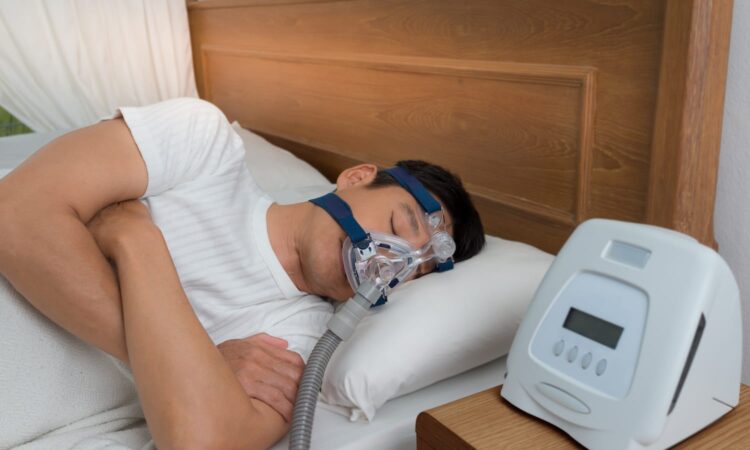Obstructive sleep apnea is a sleep condition in which a person’s airway is obstructed during sleep, resulting in shallow breathing or breathing pauses. These episodes range from a few seconds to many minutes and occur hundreds of times every night. This may result in poor sleep, exhaustion, and other health issues. Using a continuous positive airway pressure (CPAP) machine is one therapeutic option for obstructive sleep apnea. These devices continuously provide compressed air via a mask worn over the nose and mouth while the user sleeps. The compressed air keeps the airway open, enabling the user to breathe properly and sleep well.
Continuous positive airway pressure (CPAP) is a therapy option for obstructive sleep apnea, a sleep condition in which the airway gets closed during sleep, resulting in shallow breathing or breathing pauses. CPAP treatment utilises a machine to supply a consistent stream of compressed air via a mask worn over the nose and mouth while sleeping. The compressed air keeps the airway open, enabling the user to breathe properly and sleep well. Moreover, CPAP treatment successfully treats obstructive sleep apnea, increases sleep quality, and lowers the risk of additional health issues connected with sleep conditions.
What Is the Operation Of a CPAP Machine?
A CPAP machine comprises three major components: a motor, a hose, and a mask. The engine forces air into the show through the pipe. Depending on the style of cover used, the front is placed over the nose and mouth.
The engine pushes air through the hose and into the mask when you switch on the machine. The compressed air keeps the airway open and prevents it from closing during sleeping. When a person inhales, they breathe in pressured air, which keeps the airway open. Excess air is released via the mask when they live, avoiding carbon dioxide buildup.
Furthermore, a sleep expert will perform a sleep study before beginning therapy to identify the proper air pressure required for the client. This pressure is programmed into the CPAP machine and is maintained throughout the night.
Advantages Of Using A CPAP Machine
Continuous positive airway pressure (CPAP) treatment may help persons with obstructive sleep apnea, a sleep condition in which the airway is obstructed during sleep. Some of the possible advantages of utilising a CPAP machine include the following:
-
Improved Sleep Quality
A CPAP machine keeps the airway open, allowing the individual to sleep quietly without interruptions caused by shallow breathing or pauses.
-
Increased Energy and Alertness
Sleep deprivation may cause weariness and reduced attentiveness throughout the day. A CPAP machine may improve sleep quality, resulting in more power and attention throughout the day.
-
Decreased Risk of Health Problems
Obstructive sleep apnea has been related to various health issues, including hypertension, heart disease, and stroke. A CPAP machine may assist in reducing the risk of specific health concerns by treating sleep apnea.
-
Improved Quality of Life
Sleep deprivation may negatively influence one’s quality of life. A CPAP machine may enhance a person’s overall quality of life by improving sleep quality.
The Dangers And Negative Effects Of Using CPAP Machines
Continuous positive airway pressure (CPAP) therapy is generally considered safe and effective for treating obstructive sleep apnea. However, like any treatment, there may be potential side effects and risks associated with using a CPAP machine. Some common side effects of CPAP therapy include:
- Dry or congested nose: The compressed air provided by the CPAP machine may produce nasal dryness or congestion. These symptoms may be relieved by using a humidifier or saline nasal spray.
- Sore or dry throat: A painful or dry throat may also result from the compressed air. Keeping hydrated and using a throat moisturiser or tablet may ease these sensations.
- Skin irritation: The mask used during CPAP treatment may cause skin irritation, especially if it is not well-fitted. Using a cover that fits properly and applying a moisturiser to the skin may assist in avoiding inflammation.
- Headaches: When commencing CPAP treatment, some individuals may have headaches. A shift in air pressure sometimes causes this, and the headaches usually subside after a few days of using the equipment.
- Difficulty falling asleep: Some individuals may struggle to sleep with the CPAP machine on, mainly if they are not accustomed to sleeping with a mask. It may take some time to acclimate to the machine, but most people do.
Conclusion
CPAP is a very successful therapy for sleep apnea, a problem that may have significant health repercussions if left untreated. CPAP helps to keep the airways open during sleep by supplying a steady flow of air via a mask and hose. It is often suggested for patients with moderate to severe sleep apnea and has been demonstrated to enhance sleep quality and minimise the risk of problems connected with the disease. While some individuals may find it challenging to adapt to using a CPAP machine, most people find that the advantages of therapy far surpass any initial discomfort.

